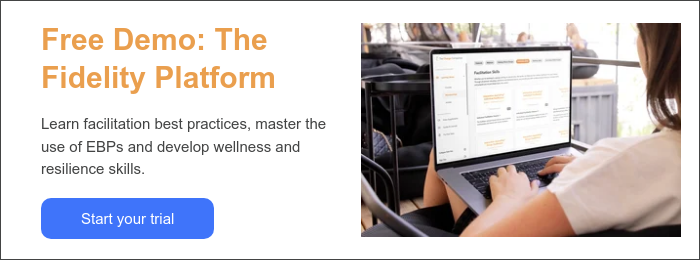Letting participants lead: Strategies for effective group process

Group process is most effective when participants are actively engaged. One way to strengthen individual involvement is to let participants lead. This approach goes hand in hand with a facilitative spirit that honors participants’ autonomy.
When participants lead, facilitators focus on structuring and guiding the group. Their job is to maintain a safe environment for the work to take place. Following a group session, facilitators can ask themselves: “Who did most of the talking, me or the participants?”
Strategies for letting participants lead:
Establish agreements and ground rules: When beginning group work with participants, it can help to collaboratively establish agreements or ground rules. When these agreements are developed collaboratively, people are more likely to feel committed to them.
Allow participants to gather ideas from the group: The chalkboard facilitation technique is a great way for the group to brainstorm ideas and record key points from discussion. Facilitators may choose to record responses themselves, but it can be better to have a volunteer act as record-keeper. Invite participants to record the group’s answers on a chalkboard, white board, flip chart or other surface. The goal is to generate a variety of responses, which then provide opportunity for discussion. If you think you have the appropriate group setting, you also might invite participants to come up and write their own responses on the board. This is a way to instill ownership among group members. It also allows you to observe participant dynamics, roles and other therapeutic data.
Invite participants to demonstrate skills: Facilitators can set up effective role-play activities by providing a clear prompt, then inviting participants to take the lead. For example, a prompt like “demonstrate assertive communication” is likely too broad. Instead, you might ask participants to come up with a list of common scenarios on the board, then choose one and demonstrate how they could use a communication skill they have learned in this situation. Another option is to have participants demonstrate both a negative and positive example, and invite the group to identify what made each one negative or positive.
Ask participants to teach concepts: Consider dividing participants into small groups and asking each group to teach a concept they have learned in your program. Encourage creativity: provide paper, markers and any other resources that might help participants think outside the box about how to present their assigned topic. Give groups sufficient time to come up with their teaching strategy, then let each group teach their concept to the full group. You also might invite volunteers to share additional ideas that have helped them in the past (e.g., strategies for getting consistent sleep, benefits of keeping a journal, tips for starting a habit of physical activity, etc.). Encourage group members to write down ideas they think will work for them.
Encourage participants to give and receive feedback: Facilitators can demonstrate giving helpful feedback to reinforce open sharing and leadership demonstrated by the group. Providing positive feedback encourages participants to continue sharing. You also can ask participants to give feedback to each other based on the skills they have learned (e.g., did the role-play match assertive communication as defined in the curriculum?). Be prepared to coach participants in how to give constructive feedback (e.g., be specific, stick to the facts, avoid intense words, speak in a calm voice, use “I” statements or “would you be willing to,” etc.). You also can help the group practice accepting feedback (e.g., be open-minded, thank the person, summarize what you heard). As needed, explain that you can accept feedback without needing to agree with the person or do exactly what they want.

